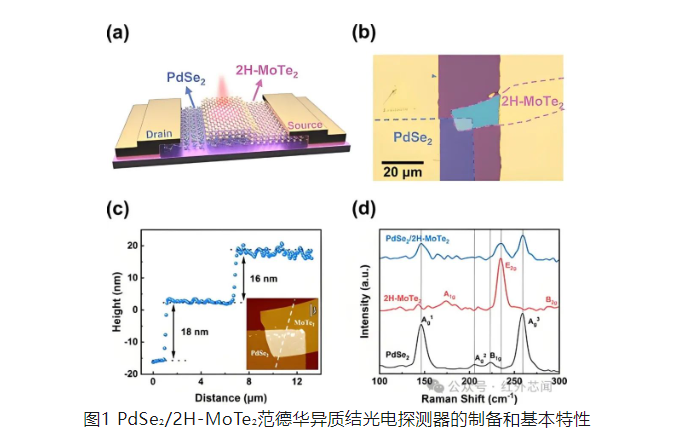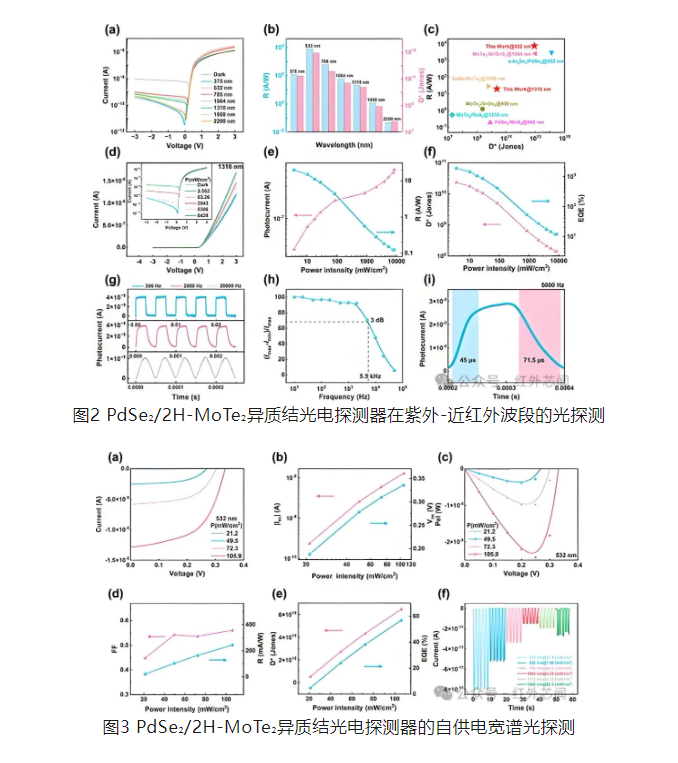18
2024
-
11
Wide spectrum heterojunction self-powered photodetector with linear and circular polarization detection capabilities
Author:
Two-dimensional (2D) materials have become a hot research topic due to their unique mechanical, optical and physical properties such as broadband response range, layer-dependent band gap, tunable electronic and optical properties, and high carrier mobility. Among them, palladium diselenide (PdSe₂) shows great potential in the field of broadband optical detection due to its tunable band gap, high carrier mobility, bipolar tunability and air stability. A heterojunction formed by van der Waals (vdW) force between two-dimensional materials exhibits excellent optical detection performance compared to a separate two-dimensional material due to a built-in electric field at its interface that facilitates separation of photogenerated carriers. In addition to wavelength and intensity, polarization is an intrinsic property of light. At present, although some progress has been made in the research of polarization devices, the exploration of polarization state (SOP) detection is still in its infancy, especially the lack of two-dimensional materials that can effectively distinguish right-handed and left-handed circularly polarized light, which is a challenge for polarization detection. However, there are also potential solutions.
According to Maims Consulting, Li Shaojuan's research team at Changchun Institute of Optics, Fine Mechanics and Physics, Chinese Academy of Sciences, has proposed a PdSe/2H-MoTe heterojunction photodetector, which demonstrates the capabilities of broadband self-powered light detection and linear/circular polarization detection. The relevant research results are entitled "PdSe2/2H-MoTe2 Heterojunction Self-Powered Photodetector: Broadband Photodetection and Linear/Circular Polarization Capability" and are published inACS NanoJournal.
In this study, PdSe₂ materials were prepared by heat-assisted conversion (TAC) method, and PdSe₂/2H-MoTe₂ heterojunction photodetectors were successfully constructed. The detector has a broadband light response and high rectification ratio, showing excellent photoelectric performance, at the same time has a self-powered detection capability, showing excellent self-powered performance, but also can detect linearly polarized light and circularly polarized light, which is integrated on-chip Full Stokes polarization detector laid the foundation. Figures 1a and 1b show schematic and optical images of the PdSe₂/2H-MoTe₂ heterojunction device.

Due to the superposition of the light detection bands of the two materials in the PdSe₂/2H-MoTe₂ heterojunction photodetector, the device can achieve ultra-broadband light detection capability from ultraviolet (UV) to near infrared (NIR). Figure 2 shows the photoelectric characteristics of the PdSe₂/2H-MoTe₂ heterojunction photodetector. Figure 3 shows the self-powered photoelectric detection characteristics of the PdSe₂/2H-MoTe₂ heterojunction photoelectric detector.

PdSe/2H-MoTe heterojunction photodetector has a wide spectral response range from 375 nm to 2200 nm, reaching a sensitivity peak at 532 nm, with a peak responsivity of 7.3 × 10 3 A/W and a detection rate of 8.5 × 10 12 Jones. The device maintains a high responsivity of 20 A/W even at 1310 nm. The self-powered light detection capability covers 375 nm to 1550 nm, the responsivity is 243 mA/W, the specific detection rate is 6.46 × 10 10 Jones, the fill factor is 0.8, and the external quantum efficiency is 56.73. The device also has the ability to detect linearly polarized and circularly polarized light simultaneously, and the relevant test results are shown in Figures 4 and 5.

To sum up, this research proposes a PdSe₂/2H-MoTe₂ heterojunction photoelectric detector with broadband self-powered photoelectric detection and linear/circular polarization detection capabilities, which is a very meaningful innovation Research results. The device exhibits excellent photoelectric performance in a wide spectral range from 375 nm to 2200 nm, and has self-powered photoelectric detection capability in a wide range from 375 nm to 1550 nm. In addition, the device can simultaneously detect linearly polarized and circularly polarized light, which provides an effective solution for the integrated all-Stokes polarization detector, and has broad application prospects in the field of near-infrared polarization detection.
LATEST NEWS
2024-10-05
Calculation of the diffracted light field: Regarding Fresnel near-field diffraction, how should the field distribution be calculated after a plane wave encounters a metasurface and experiences a phase jump?
Previously, a friend wanted to see the source code for the article 'Matlab Optical Fresnel Diffraction, Dynamic Visualization of Matlab Curves and Graphics', and the source code is included in this article.
2024-11-15
Academician Chang Ruihua's team has made new progress in short-distance optical communication high-speed interconnection technology.
850nm wavelength multimode vertical-cavity surface-emitting lasers (VCSELs) and multimode fibers (MMFs) have become the ideal choice for short-distance optical interconnects in data centers and supercomputing systems due to their low power consumption and cost-effectiveness.
2024-11-18
Wide spectrum heterojunction self-powered photodetector with linear and circular polarization detection capabilities
Two-dimensional (2D) materials have become a hot research topic due to their unique mechanical, optical and physical properties such as broadband response range, layer-dependent band gap, tunable electronic and optical properties, and high carrier mobility.
2024-11-07
Spin-based Schrodinger Cat States Prepared by Laser Cold Atom Method
The spin-based Schrodinger cat state is prepared by laser cold atom method, and its lifetime reaches the order of minutes, which helps to improve the measurement sensitivity of spin precession phase.

